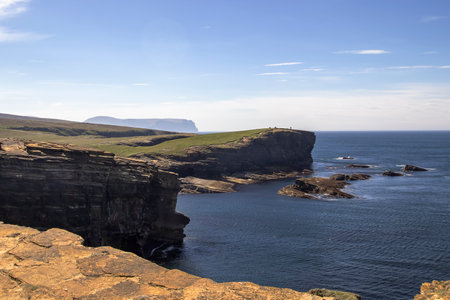Introduction to Scotland’s Iconic Coastal Walks
There’s something truly magical about exploring Scotland’s coastline on foot. Stretching for thousands of miles, the Scottish coast offers an astonishing variety of scenery—from dramatic cliffs and golden beaches to peaceful fishing villages and ancient castles. Whether you’re a seasoned rambler or just looking for a weekend family stroll, Scotland’s coastal paths have something for everyone. With well-marked trails like the famous Fife Coastal Path and the legendary route up to John o’ Groats, walkers of all ages are invited to discover the nation’s natural beauty at their own pace. Along the way, you’ll experience the gentle rhythm of the waves, encounter wildlife such as puffins and seals, and enjoy friendly banter with locals in charming seaside towns. Walking these routes is more than just exercise; it’s a way to connect with Scotland’s rich heritage and ever-changing landscapes, making each journey along the shore a uniquely rewarding adventure.
Exploring the Fife Coastal Path
If you’re keen to immerse yourself in Scotland’s coastal splendour, the Fife Coastal Path is a brilliant place to start. Stretching from Kincardine to Newburgh, this well-loved route offers over 117 miles of ever-changing scenery and is perfect for both seasoned walkers and families looking for a gentle adventure.
From Kincardine to Newburgh: A Journey Through Nature and History
The journey begins at Kincardine, winding past dramatic cliffs, golden sands, and quaint villages that seem lifted straight from a storybook. As you meander along the path, you’ll discover:
| Stop | Highlight | Family-friendly Features |
|---|---|---|
| Kincardine | Historic bridge views, riverside strolls | Easy paths suitable for pushchairs |
| Culross | Charming 17th-century village, cobbled streets | Cafés with children’s menus, public loos |
| Elie & Earlsferry | Sandy beaches, lighthouse spotting | Paddling spots, safe swimming areas |
| Anstruther | Picturesque harbour, famous fish & chips | Play parks nearby, boat trips to Isle of May |
| St Andrews | Historic university town, castle ruins | Museums with interactive exhibits, picnic spots |
| Newburgh | Tay Estuary views, local wildlife watching | Accessible walking trails, bird hides for kids |
Hidden Beaches and Secret Spots Along the Way
The Fife Coastal Path isn’t just about its charming villages; it’s dotted with secluded coves and hidden beaches perfect for a family picnic or a quiet moment away from it all. Look out for Shell Bay and Kingsbarns Beach—both offer unspoilt sands where little ones can hunt for seashells or dip their toes in the North Sea.
Why Families Love This Route
This stretch of coastline is packed with family-friendly stops—think play parks with sea views, welcoming tearooms serving home bakes, and plenty of places to spot seals or seabirds. Whether your family prefers a leisurely stroll or an energetic day out, the Fife Coastal Path promises memories made together against some of Scotland’s most breathtaking backdrops.

3. The Dramatic Beauty of the Moray Coast Trail
If you’re yearning for a walk that truly captures Scotland’s wild spirit, the Moray Coast Trail is an absolute gem. Hugging the north-east coast between Forres and Cullen, this route is beloved for its ever-changing scenery, making it a highlight for families, nature lovers, and keen photographers alike.
Wild Cliffs and Crashing Waves
The trail leads you along dramatic cliffs, where the North Sea crashes below and the salty breeze fills your lungs. Each twist and turn reveals sweeping vistas—perfect for those who appreciate rugged landscapes and want to feel miles away from city life.
Dolphin Spotting Adventures
One of the true joys of this walk is the chance to spot playful dolphin pods leaping in the Moray Firth. The area is famous for its resident bottlenose dolphins, so keep your eyes peeled as you stroll along cliff tops or pause at quiet coves. It’s a magical experience for both children and adults.
Historic Lighthouses & Seaside Villages
The Moray Coast Trail also takes you past charming fishing villages like Findochty and Portknockie, each with their own character and stories to tell. Don’t miss the iconic Covesea Lighthouse near Lossiemouth—a striking reminder of Scotland’s maritime heritage and a fantastic spot for family photos.
Whether you’re hoping to snap that perfect shot of sunlit cliffs or simply breathe in the fresh coastal air with loved ones, the Moray Coast Trail offers an unforgettable slice of Scottish adventure. It’s accessible yet awe-inspiring—just right for anyone wanting to discover why Scotland’s coastal walks are so treasured.
4. Walking the West Highland Way: Coastal Adventures
While the West Highland Way is celebrated for its dramatic highland scenery, many walkers overlook the charming seaside sections that offer a unique taste of Scotland’s coastal magic. From gentle lochsides to windswept beaches and secluded coves, these portions of the trail invite families and seasoned hikers alike to immerse themselves in the wild beauty of Scotland’s western shores.
Unveiling the Seaside Segments
The journey begins near the shores of Loch Lomond, where tranquil waters meet forested banks. As you continue northward, the route brushes against atmospheric stretches like Inverarnan and Crianlarich before drawing closer to the coastline near Fort William. Here, panoramic views unfold over sea lochs and distant islands, offering some of the most unforgettable vistas on the trail.
Highlights Along the Coastal Route
| Location | What Makes It Special |
|---|---|
| Loch Lomond Shores | Peaceful woodland paths beside glistening water—perfect for picnics and family strolls. |
| Ardlui to Crianlarich | Dramatic shoreline walks with glimpses of local wildlife, such as ospreys and deer. |
| Approaching Fort William | Sweeping views across Loch Linnhe towards distant Hebridean islands. |
Cosy Inns and Warm Welcomes
No Scottish adventure is complete without a friendly inn or B&B to rest your feet. Along the West Highland Way’s coastal sections, you’ll find traditional pubs serving hearty fare—think locally caught seafood and warming stews—alongside family-run guesthouses where tales of the day’s walk are shared by a crackling fire. These stops aren’t just practical; they’re part of what makes this journey truly special for families and solo explorers alike.
Tips for Enjoying Coastal Walks on the West Highland Way
- Pack layers: The weather can change quickly along the coast, so be prepared for both sunshine and showers.
- Look out for wildlife: From playful otters to soaring sea eagles, keep binoculars handy for spontaneous sightings.
- Book ahead: Especially in summer months, seaside inns fill up fast—reserve your accommodation early for peace of mind.
- Savour local flavours: Don’t miss traditional treats like Cullen skink or freshly baked oatcakes at village cafés along your route.
The seaside stretches of the West Highland Way blend rugged landscapes with moments of quiet reflection and warm hospitality. Whether you’re after breathtaking views, nature encounters, or simply a chance to bond with loved ones over a coastal ramble, these segments promise memories that linger long after you’ve returned home.
5. Journey to John o’ Groats: Scotland’s Northern Edge
If you’re seeking the ultimate coastal adventure, the journey to John o’ Groats is a must for any walker exploring Scotland’s dramatic shorelines. As the northernmost point of mainland Britain, John o’ Groats holds legendary status—standing here, with windswept hair and endless views over the Pentland Firth, is an experience that captures the wild spirit of Scotland.
Reaching the Iconic Tip
The walk to John o’ Groats is suitable for all levels, from keen ramblers to families looking for a memorable outing. The route can be as challenging or as gentle as you wish, with shorter sections perfect for little legs or full-day treks for those wanting more adventure. Along the way, you’ll pass through rugged cliff paths, quaint fishing villages, and stretches of untouched coastline. Don’t forget your camera—this is where the land truly meets the sea in spectacular fashion!
Family-Friendly Tips
Travelling with children? The path near John o’ Groats offers several easy-access points and picnic spots where you can pause for a sandwich and take in the scenery. Many families enjoy visiting Duncansby Head nearby, where striking sea stacks rise dramatically from the water—a great place for a bit of wildlife spotting too! Be sure to dress in layers and pack waterproofs; Scottish weather can be unpredictable even in summer.
For First-Time Coastal Walkers
If it’s your first time tackling a Scottish coastal walk, start with manageable distances and check local maps before heading out. The terrain can vary from grassy tracks to pebbly beaches, so sturdy walking boots are recommended. Facilities at John o’ Groats village include a café and souvenir shops, making it easy to reward yourselves after a day of exploration.
Whether you’re completing a long-distance challenge or simply enjoying a family stroll along Scotland’s northern edge, arriving at John o’ Groats feels like reaching the end of an epic story—one filled with bracing sea air, stunning views, and memories that will last a lifetime.
6. Tips for Coastal Walkers: Local Insights and Practical Advice
Packing Essentials for the Scottish Coast
Before you set off on your adventure along Scotland’s stunning coastline, make sure to pack wisely. Weather here is famously unpredictable, so layering is key — think waterproof jackets, warm jumpers, and sturdy walking boots that can handle a bit of mud and shingle. Don’t forget a good hat and gloves, even in summer, as breezes off the North Sea can be brisk. A refillable water bottle and plenty of snacks will keep everyone energised, especially if you’re travelling with family or little ones.
Understanding the Weather
Scottish weather is part of the charm, but it pays to be prepared! Always check the local forecast before heading out and be ready to adapt your plans if conditions turn. Coastal fog can roll in quickly, and rain showers are common year-round. Having a lightweight waterproof layer handy will help keep spirits high whatever the skies decide.
Getting Around: Public Transport and Accessibility
One of the joys of Scotland’s coastal walks is their accessibility by public transport. Trains and local buses connect many starting points, like Leven on the Fife Coastal Path or Wick near John o’ Groats. Planning your journey ahead with Transport Scotland’s journey planner or local bus timetables ensures a smooth trip. For families, check for child fares or group tickets that can make travelling more budget-friendly.
Respecting Local Wildlife and Traditions
The coast is teeming with wildlife — from puffins and seals to rare seabirds nesting in cliffside colonies. Keep a respectful distance from animals, stick to marked paths, and avoid disturbing nesting sites during spring and early summer. Remember to take all litter home with you; “leave no trace” helps preserve these stunning landscapes for generations to come.
Embracing Local Culture
Many coastal communities have traditions worth experiencing — from small harbourside fish suppers to village festivals celebrating maritime heritage. Take time to chat with locals in pubs or cafés; their stories often add rich layers to your walk. Supporting independent shops and sampling regional treats like Cullen skink or freshly caught seafood is all part of the journey.
A Worry-Free Adventure for All
With just a bit of planning and respect for nature and local customs, your Scottish coastal walk will be filled with breathtaking views and warm welcomes. Whether tackling a short family stroll or a multi-day trek, these tips will help ensure your adventure is memorable, safe, and truly special.


